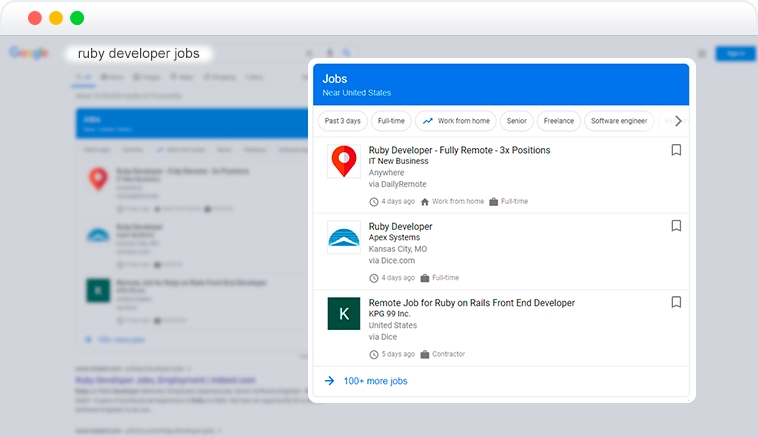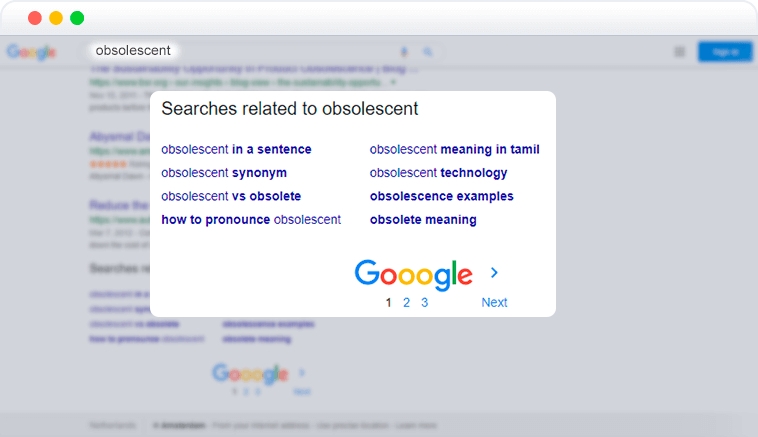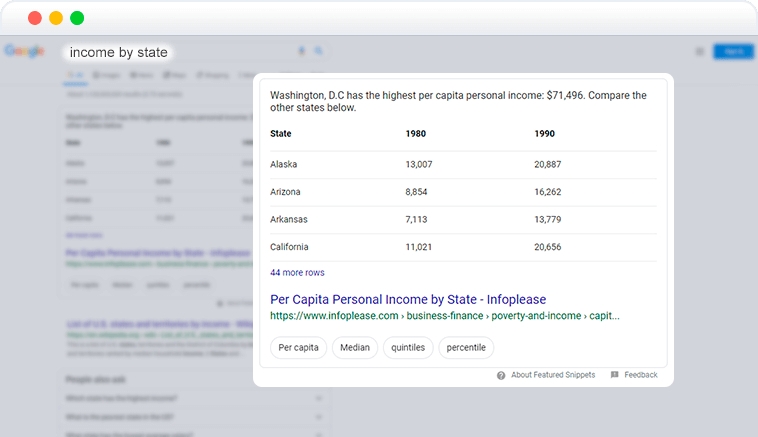How to Track Featured Snippets And Other SERP Features in RankActive
17 June 2021 Leave a comment ALL-HANDS SEO
Google does its best to simplify a searcher’s life. While delivering the most relevant results for our queries, it constantly develops new features, enabling us to find the information we need much faster.
Thanks to SERP elements surfacing answers to user questions directly in search results, you no longer need to navigate numerous websites to find relevant info. Now, all it takes is to type a query into the search bar, hit Enter, and let Google take care of the rest.
From a user perspective, these novelties do make our lives much easier. Yet, when it comes to SEO, it’s not all roses.
According to Rand Fishkin’s study, more than 50% of searches on Google end up with no clicks on organic results. So here is a twist: while simplifying your searching routine, SERP features steal the traffic that could potentially go to your website.
While we can complain here all day long — it won’t change anything. SERP features have become an inevitable part of the search experience, and they have also become an inevitable part of rank tracking tools.
Today, every advanced tool considers extra SERP elements when calculating rankings.
But why can’t you just monitor organic rankings and don’t pay attention to anything else? The following paragraphs will answer this question.
There are two reasons why you shouldn’t forget about SERP features when tracking rankings:
- By tracking extra SERP elements, you get precise ranking data. If you track rankings only in organic search, the positions you will get for each keyword will be inaccurate, which may mislead you. Let’s say you own an e-commerce store and rank first in organic search for the Buy washing machine keyword. You know that this keyword has a high search volume, so it should bring you a lot of traffic. Yet, you open the Search Console and notice you get fewer visitors than you expect. Why? That’s because of extra SERP features. There may be lots of paid results, shopping snippets, people also ask elements, and other features displayed above organic results. They steal a good portion of your traffic, and you don’t even know about this.
- Also, by tracking which SERP features are available for a specific keyword, you’ll be able to estimate the keyword’s traffic potential more accurately. For example, if you rank fifth for the How old is Elon Mask keyword, there is no point in improving your position for it. Even though it has a pretty high search volume, there is an answer box for this keyword, which means users will get their answers immediately and won’t have to click anywhere. Thus, you probably won’t get much traffic even if you manage to rank first in organic search for the query.
Luckily, with RankActive’s Rank Tracker, you can discover SERP elements available for your project keywords and check whether your website appears in them.
Unlike most rank tracking tools, RankActive allows you to choose which SERP features to track.
To get everything started, create a project, add your website, and specify the keywords you want to monitor. Once it’s done, go to Settings and select the SERP types to track.
Please note. Our tool calculates positions based on the SERP types you have added. So if you don’t add a specific element, it won’t be taken into account when calculating rankings.
For example, if your site ranks first in organic search for the How to choose a mountain bike keyword, and there is a featured snippet for the keyword, Rank Tracker will display your position as first or second, depending on whether you’ve added featured_snippet as a SERP type to track.
Once you add the desired SERP types, go to the Detailed view section of the tool. Here, you will find a table with numerous columns. Go to the Column Chooser and pull out the SERP Elements and Ranked SERP Element columns.
Under the SERP Elements column, you will find the SERP features that are available for a keyword. It displays all the elements that appear for a certain keyword, whether you’ve added them or not.
The Ranked SERP Element column displays the extra SERP elements your website appears in for a specific query.
Currently, you can track 18 SERP features. However, not all of them are relevant to your niche, so let’s discuss which extra elements you should monitor and which not.
Below we describe the SERP features available in Rank Tracker in the order in which they’re presented in Settings. Hopefully, this information will help you choose which extra SERP elements to monitor.
Paid
Paid results are ads powered by Google that are often displayed above organic search results. While their CTRs are lower than those of organic snippets, they may still take away some clicks from organic results, so it’s a good idea to track the availability of these elements in SERP. Moreover, ads appear almost for any niche, even for informational queries, so you definitely shouldn’t disregard them when tracking rankings.
Also, note that paid results are unstable. Today, there may be no ads for a specific keyword, while tomorrow Google can display several ads for it. Thus, you will see constant fluctuations in website positions in your reports. So the point is, you may or may not track paid results, depending on what you want to be included in your reports.
Is the feature worth tracking: It depends.
What type of businesses should track it: Any.
Top Stories
Top stories are news elements that may appear above and below organic results. They surface three news items available for a keyword with pointers to websites that store them. This extra SERP element is relevant mostly for news websites, so you should track it if you own such a website. Otherwise, the Top stories element is of no use for you.
Is the feature worth tracking: It depends.
What type of businesses should track it: News websites.
People also ask
The People also ask element represents questions related to a user query. It comes in the form of expandable boxes with questions and answers. Each answer has a link to the website storing it, so a user can visit the source and study a topic further. People also ask is a widespread SERP feature that may steal your traffic and appear both for informational queries and keywords with commercial intent. Therefore, we believe you should track this element regardless of your niche.
Is the feature worth tracking: Yes.
What type of businesses should track it: Any.
Local Pack
Local pack provides a list of local establishments located nearby and relevant to a user query. This feature is displayed above organic results in the 3-pack form and provides general information about local establishments, including their names, ratings, addresses, GMB attributes, photos, and other info. Tracking local packs makes sense only if you have a local business and rank for keywords with local intent.
Is the feature worth tracking: It depends.
What type of businesses should track it: Local companies that rank for local intent keywords.
Carousel
Carousel displays information relevant to a user query in the form of an element list. It usually appears for informational queries when a user is deliberately looking for a list of some items (e.g., Stephen King’s Books, Breaking Bad Cast, Nikola Tesla’s inventions, and so on). Even though carousels appear above organic results, they don’t send searchers to any website but redirect them to a related search session (when a user clicks on an element, Google starts a new search for this element’s name). Thus we believe tracking carousels is not necessary in the vast majority of cases.
Is the feature worth tracking: No.
What type of businesses should track it: –
Images
The Images element appears when a user searches for a query related to visual content. It has the form of an image row and is often displayed inside SERP along with organic snippets (although, sometimes, it shows up on the top of SERP). Images have pointers to websites storing them, so they can potentially steal your traffic (or your site can also appear in this section, bringing you visitors). That’s why it’s a good practice to monitor Images in Rank Tracker.
Is the feature worth tracking: Yes.
What type of businesses should track it: Any.
Video
Like images, the Video element is presented in a row that usually contains three videos. Most videos from such rows link to YouTube. However, if a user clicks View all, they may also find websites that have embedded videos from YouTube and other platforms. Given that videos may steal some clicks from organic results, you should keep an eye on them when tracking rankings.
Is the feature worth tracking: Yes.
What type of businesses should track it: Any.
Map
As the title suggests, the Map feature is designed to offer users a map of a place when they deliberately search for it. This element just provides information and doesn’t send searchers anywhere, so it isn’t worth your attention.
Is the feature worth tracking: No.
What type of businesses should track it: –
The Twitter extra element is displayed when a subject of a search query is associated with the relevant Twitter account or when a Twitter post can provide additional information on the subject. It surfaces three Twitter posts from a relevant account. While Twitter elements may steal clicks from organic snippets, they are rare and appear for a very narrow list of keywords. That’s why we wouldn’t recommend monitoring them in Rank Tracker.
Is the feature worth tracking: No.
What type of businesses should track it: –
App
The App SERP feature appears when Google can offer apps related to a user query. This element shows up only in mobile search results. Apps are available for a very narrow list of keywords, mostly branded terms that contain application titles (e.g., Spotify, YouTube Music, Shazam, etc.) or some query + app (e.g., weight loss app, app for runners, and so on). Thus, if your business has a mobile app, it’s a good idea to track the app element using Rank Tracker.
Is the feature worth tracking: It depends.
What type of businesses should track it: Any businesses that have mobile apps.
Shopping
Shopping elements are ads powered by Google that usually appear for buyer intent keywords. These advertisements are displayed on the right of other SERP elements, contain images, pricing information, and links to online stores. Thus, they may steal clicks from e-commerce stores ranking organically. If you are an e-commerce store owner and rank for buyer intent keywords, we recommend monitoring shopping snippets in Rank Tracker.
Just like with paid results, you never know when someone will start running shopping ads for the keywords you track and mess up your ranking reports.
Is the feature worth tracking: It depends.
What type of businesses should track it: E-commerce stores.
Google Flights
Google Flights is designed to provide information about flights between two destinations for the selected dates. It usually appears when a user types an origin and a destination + word “flights” into the search bar (e.g., London Berlin flights). Using this feature, searchers can buy tickets from one of the airlines listed in Google Flights. Thus, tracking this feature makes sense only for someone who sells flying tickets on their sites.
Is the feature worth tracking: It depends.
What type of businesses should track it: Flight aggregators, travel agencies, and other businesses related to the travel niche.
Jobs
The Jobs element represents the list of jobs relevant to a user query. It usually appears when a searcher is looking for a job and specifies their intent in the search query (e.g., php developer jobs, SEO writer jobs, nurse jobs). Using this feature, job seekers can apply their resumes through one of the job search websites listed in Jobs. Thus, the Jobs feature may steal some CTRs from job search websites that rank organically but don’t show up in the list. If you own such a website and rank for job-related keywords, it’s a good idea to track this element.
Please note, the feature is powered by a designated Google service, so you can appear in the Jobs box only if you’re a partner.
Is the feature worth tracking: It depends.
What type of businesses should track it: Job search websites.
Answer box
Answer box provides a direct answer to a user question. This element shows up for queries that can be answered briefly (e.g., how tall is Eiffel Tower, how old is Stephen King, when ww2 ended, and so on). Even though answer boxes don’t send users anywhere, you should keep an eye on them to know which keywords aren’t worth your attention. As explained above, if some keyword has an answer box in SERP, it’s probably pointless to optimize for it. In addition to that, sometimes answer boxes appear along with featured snippets, which take some clicks away from organic results.
Is the feature worth tracking: No.
What type of businesses should track it: –
Related
Related searches usually appear at the bottom of search result pages. They’re designed for users who couldn’t find answers to their initial queries. If a user went through the TOP10 pages in SERP, it’s unlikely they would go to pages two or three to find a relevant result. That’s why Google suggests related queries at the end of the page so that the user can rephrase their original term. Given that related searches appear at the bottom of SERP and don’t send users to third-party websites, we wouldn’t track this element in Rank Active.
Is the feature worth tracking: No.
What type of businesses should track it: –
Mention
The Mention element (also known as the mention carousel) depicts the set of trustworthy references to a user query. It is usually displayed among organic results in SERP. This feature shows up primarily for buyer intent keywords and often provides links to product-review websites. With that in mind, we think tracking the mention element is a good idea for e-commerce stores.
Is the feature worth tracking: It depends.
What type of businesses should track it: E-commerce stores.
Hotels pack
The Hotels pack feature shows up at the top of SERP for someone looking for a place to stay in a specific location. It displays the map of the area along with a list of places to visit. Using this feature, a searcher can book a place via one of the booking websites listed in the hotels pack. Thus, this element may steal clicks from other booking websites or hotel sites ranking organically. If you own such a website, you should monitor the Hotels pack in Rank Tracker.
Is the feature worth tracking: It depends.
What type of businesses should track it: Businesses that operate in the hospitality industry.
Featured snippet
Featured snippets are boxes displayed at the top of SERP that contain a brief answer to a user query. They usually show up for informational intent keywords and provide an excerpt from relevant content with the link to it. Given that featured snippet is a widespread element, which always appears above organic results and has a pointer to a website, you should track this element regardless of your niche.
Is the feature worth tracking: Yes.
What type of businesses should track it: Any.
We hope now you understand the importance of tracking SERP features and know which elements you should monitor. Sign up to RankActive right now and get accurate ranking data for your website. We offer a 14-day free trial, so don’t hesitate to create your account.
Tags: Extra SERP elements, Rank Tracker, RankActive, Rankings, SERP features
Like this article? There’s more where that came from.
- 5 Questions to Ask Yourself Before Paying for Rank Tracking Software
- 5 Serious Mistakes Beginner SEOs Make and How to Fix Them
- Why We Use Google’s New Link Attributes and You Should Too
- Title and Description in 2021: Why Google Rewrites SEOs’ Meta Tags
- What We Should Learn From Google’s “About This Result” Feature





















